
1. Introduction to ASCII code
ASCII (American Standard Code for Information Interchange, American Standard Code for Information Interchange) is a set of character encodings based on Latin letters. A total of 128 characters are included, which can be stored in one byte. It is equivalent to the international standard ISO/IEC 646. The ASCII specification was first published in 1967 and last updated in 1986.
The ASCII encoding range is 0x00-0x7F, which is 0-127 in decimal, defining 128 single-byte characters. It contains 33 control characters (characters that have some special functions but cannot be displayed) and 95 displayable characters (numbers, letters, symbols). The national standard code GB18030 and the international code Unicode are both compatible with ASCII encoding.
2.ASCII code comparison table

3.The reason for the generation of ASCII code
In the computer, all data is stored and processed Binary numbers must be used when expressing (because computers use high and low levels to represent 1 and 0 respectively). For example, 52 letters (including uppercase) like a, b, c, d and numbers such as 0 and 1 are also represented. Some commonly used symbols (such as *, #, @, etc.) are also represented by binary numbers when stored in the computer. Of course, everyone can agree on which binary numbers are used to represent which symbol. (This is (called encoding), and if everyone wants to communicate with each other without causing confusion, then everyone must use the same encoding rules. Therefore, the relevant standardization organizations in the United States introduced ASCII encoding, which uniformly stipulates which binary numbers are used to represent the above common symbols. .
The American Standard Code for Information Interchange was developed by the American National Standard Institute (ANSI) and is a standard single-byte character encoding scheme for text-based data. It was originally an American national standard and was used as a common Western character encoding standard for different computers to communicate with each other. Later, it was established as an international standard by the International Organization for Standardization (ISO), called the ISO 646 standard. Applies to all Latin script letters.
The above is the detailed content of ASCII code comparison table. For more information, please follow other related articles on the PHP Chinese website!
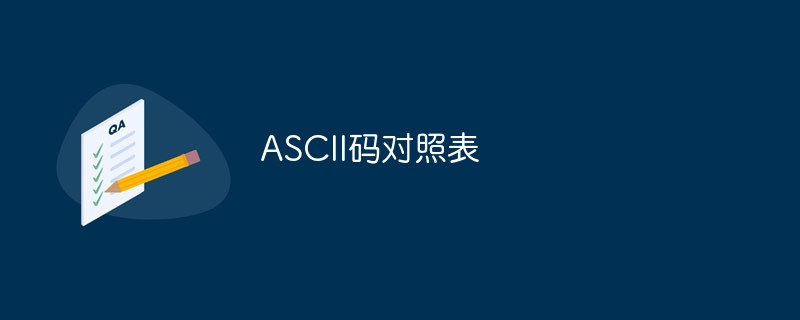 ASCII码对照表Jun 21, 2023 pm 05:36 PM
ASCII码对照表Jun 21, 2023 pm 05:36 PMASCII(American Standard Code for Information Interchange,美国信息互换标准代码)是一套基于拉丁字母的字符编码,共收录了 128 个字符,用一个字节就可以存储,它等同于国际标准 ISO/IEC 646。ASCII 规范于 1967 年第一次发布,最后一次更新是在 1986 年。
 d的ascii码值是多少Feb 02, 2023 am 11:26 AM
d的ascii码值是多少Feb 02, 2023 am 11:26 AMd的ascii码值是100;因为a的ASCII代码值是十六进制数61H,即十进制值是97,而d在a后三位,则d的ASCII代码值是“97+3=100”;ASCII码使用指定的7位或8位二进制数组合来表示128或256种可能的字符。
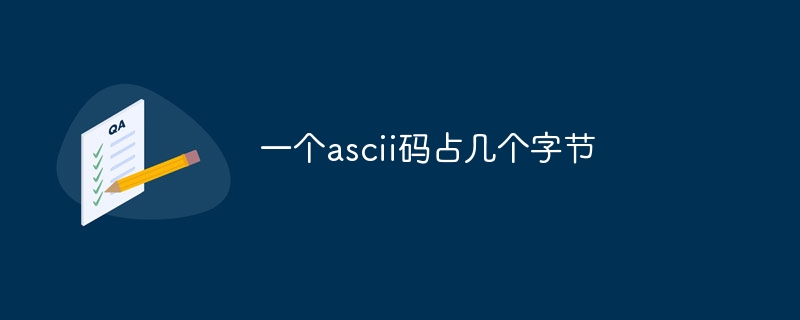 一个ascii码占几个字节Sep 07, 2023 pm 04:03 PM
一个ascii码占几个字节Sep 07, 2023 pm 04:03 PM一个ascii码占一个字节,ascii码是一种用于表示字符的编码标准,它使用7位二进制数来表示128个不同的字符,包括字母、数字、标点符号和特殊字符等。一个字节是计算机存储单位的基本单元,它由8个二进制位组成,每个二进制位可以是0或1,一个字节可以表示256个不同的数值,因此可以表示ascii码中的所有字符。
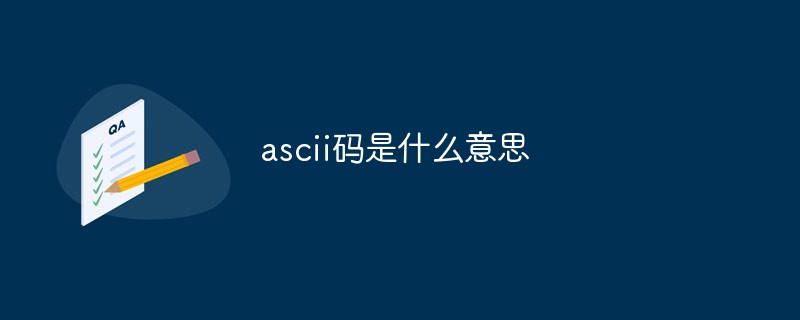 ascii码是什么意思Jul 18, 2022 am 11:15 AM
ascii码是什么意思Jul 18, 2022 am 11:15 AMascii码是基于拉丁字母的一套电脑编码系统;ascii码是“American Standard Code for Information Interchange”的简写,主要用于显示现代英语和其他西欧语言,是最通用的信息交换标准,使用指定的7位或8位二进制数组合来表示128或256种可能的字符。
 一个字符的标准ascii码占一个字节的存储量吗Aug 02, 2022 pm 04:39 PM
一个字符的标准ascii码占一个字节的存储量吗Aug 02, 2022 pm 04:39 PM是的,一个字符的ASCII码占用存储空间为1个字节。在ASCII码表中,根据码值由小到大的排列顺序是:控制符、数字符、大写英文字母、小写英文字母。ASCII码是西文编码,主要用于显示现代英语和其他西欧语言,一个码占一个字节。
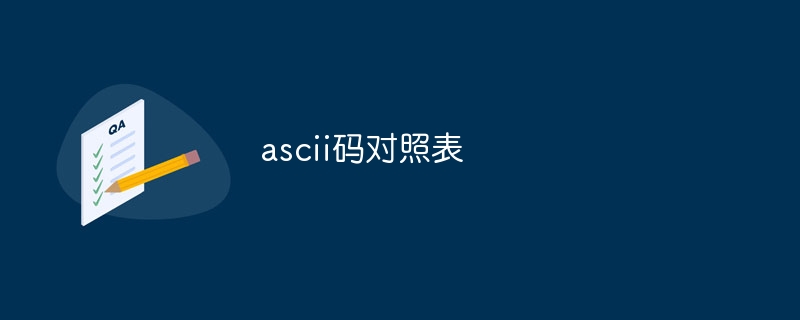 ascii码的对照表Jan 15, 2024 pm 04:30 PM
ascii码的对照表Jan 15, 2024 pm 04:30 PMASCII码即“American Standard Code for Information Interchange”,美国信息交换标准代码:1、 0,NUL;2、 1,SOH;3、2,STX;4、3,ETX等等,ASCII码包括许多其他字符和符号。每个字符都与一个唯一的整数值相对应,这些整数值被称为ASCII码。
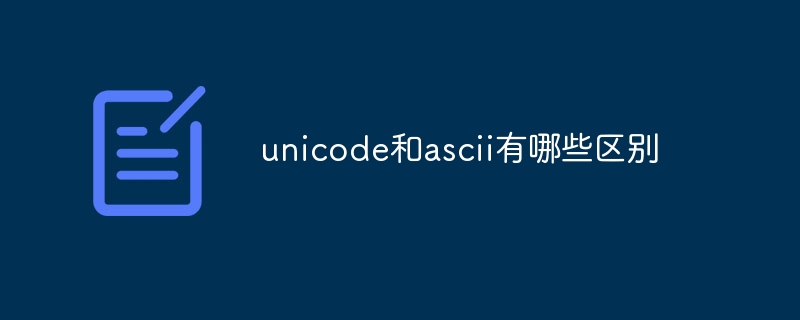 unicode和ascii有哪些区别Sep 06, 2023 am 11:56 AM
unicode和ascii有哪些区别Sep 06, 2023 am 11:56 AMunicode和ascii的区别包括编码范围不同、存储空间不同和兼容性不同等。详细介绍:1、编码范围不同,ascii的编码范围是0-127,主要用于表示英语字母,而unicode的编码范围广阔得多,可以表示几乎所有的语言字符;2、存储空间不同,ascii通常使用1个字节来存储一个字符,而unicode可能使用2个或更多的字节来存储一个字符;3、兼容性不同等等。
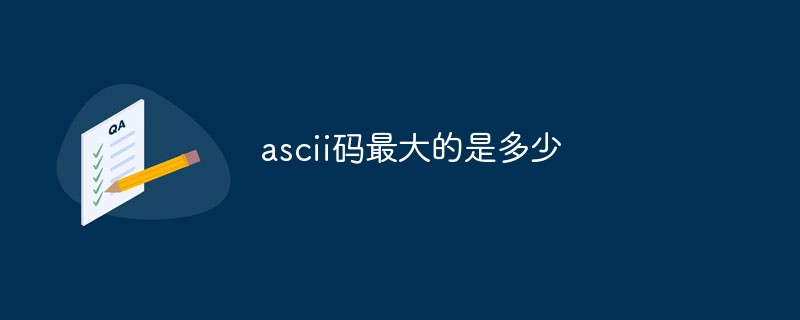 ascii码最大的是多少Mar 06, 2023 pm 01:48 PM
ascii码最大的是多少Mar 06, 2023 pm 01:48 PMascii码最大的是127。ASCII码是美国信息交换标准代码是基于拉丁字母的一套电脑编码系统,主要用于显示现代英语和其他西欧语言。标准ASCII码是用7个二进制位表示1个字符,共有编码128个;其中0到31及127是控制字符或通信专用字符(其余为可显示字符)、32到126是字符、65到90为26个大写英文字母,97到122号为小写英文字母,其余为一些标点符号、运算符号等。

Hot AI Tools

Undresser.AI Undress
AI-powered app for creating realistic nude photos

AI Clothes Remover
Online AI tool for removing clothes from photos.

Undress AI Tool
Undress images for free

Clothoff.io
AI clothes remover

AI Hentai Generator
Generate AI Hentai for free.

Hot Article

Hot Tools

mPDF
mPDF is a PHP library that can generate PDF files from UTF-8 encoded HTML. The original author, Ian Back, wrote mPDF to output PDF files "on the fly" from his website and handle different languages. It is slower than original scripts like HTML2FPDF and produces larger files when using Unicode fonts, but supports CSS styles etc. and has a lot of enhancements. Supports almost all languages, including RTL (Arabic and Hebrew) and CJK (Chinese, Japanese and Korean). Supports nested block-level elements (such as P, DIV),

Safe Exam Browser
Safe Exam Browser is a secure browser environment for taking online exams securely. This software turns any computer into a secure workstation. It controls access to any utility and prevents students from using unauthorized resources.

MinGW - Minimalist GNU for Windows
This project is in the process of being migrated to osdn.net/projects/mingw, you can continue to follow us there. MinGW: A native Windows port of the GNU Compiler Collection (GCC), freely distributable import libraries and header files for building native Windows applications; includes extensions to the MSVC runtime to support C99 functionality. All MinGW software can run on 64-bit Windows platforms.

Notepad++7.3.1
Easy-to-use and free code editor

SublimeText3 Linux new version
SublimeText3 Linux latest version






